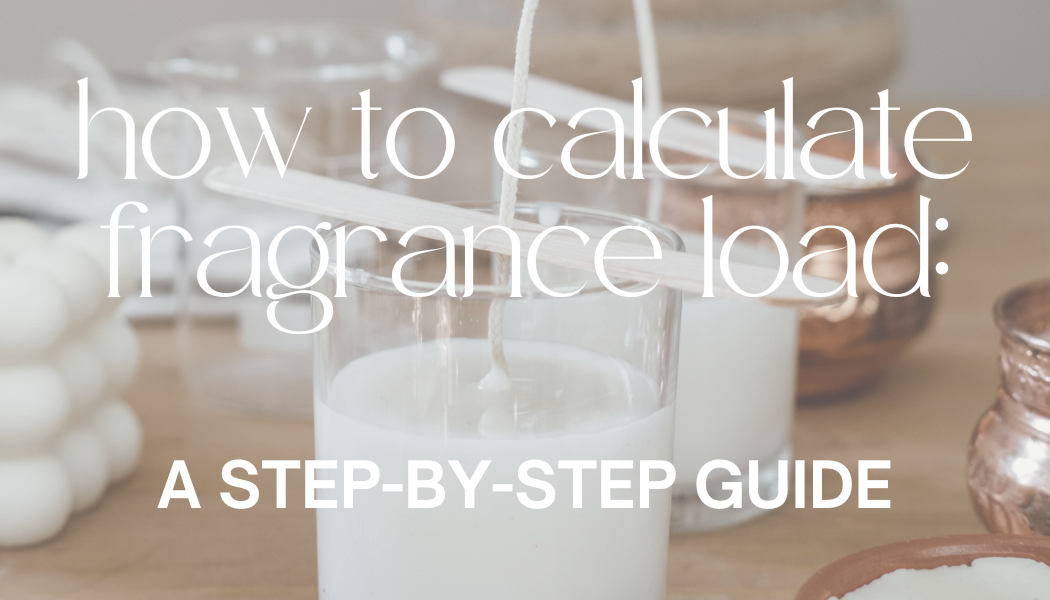How to Calculate Fragrance Load for Wax Products: A Step-by-Step Guide

One of the most common questions we get from our community of candle and wax melt makers is: How do I calculate the right fragrance load for my candles or wax melts? Whether you’re new to the craft or a seasoned pro, balancing wax and fragrance oil can sometimes feel like cracking a secret code. But don’t worry! We’ve got you covered.
In this post, we’ll walk you through how to calculate fragrance load manually so you can fully understand the formula. Then we’ll show you how our Fragrance Load Calculator takes the guesswork out of the process, so you can focus on what you love—creating beautiful, fragrant wax products!
Why Does Fragrance Load Matter?
Before diving into the math, let’s talk about why fragrance load is so crucial. Fragrance load is the percentage of fragrance oil compared to the total weight of your candle or wax melt. It ensures that your product smells amazing without overwhelming the senses or causing performance issues.
Too little fragrance might leave you with a weak scent, but too much can cause problems like poor burn quality, safety concerns, or “sweating” (when excess oil seeps out of the wax). That’s why getting the fragrance load just right is key to creating a product that performs well and smells incredible.
The Formula: How to Calculate Fragrance Load Manually
If you want to calculate the amount of fragrance oil needed for your wax product manually, here’s a simple formula you can follow:
Fragrance Oil Amount = Total Weight of Candle × (Fragrance Load Percentage ÷ 100)
Here’s a step-by-step breakdown:
- Decide on your fragrance load percentage – Let’s say you want to use an 8% fragrance load.
- Determine your total candle weight – For example, you’re making a candle with a total weight of 16 oz (this includes both wax and fragrance oil).
-
Calculate the amount of fragrance oil – Multiply the total weight of your candle by your fragrance load percentage (converted to a decimal):
16 oz × (8 ÷ 100) = 1.28 oz fragrance oil
-
Calculate the amount of wax – Subtract the fragrance oil weight from the total candle weight:
16 oz − 1.28 oz = 14.72 oz of wax
So, if you’re making a 16 oz candle with an 8% fragrance load, you’ll need 1.28 oz of fragrance oil and 14.72 oz of wax.
But hey, let’s be real—if you don’t love doing math every time you want to pour a batch of candles, we’ve got you covered with an easier way!
How to Use the Fragrance Load Calculator
Our calculator takes care of all the calculations for you! Here’s a quick guide on how to use it:
- Start with your total weight: Enter the combined weight of wax and fragrance oil for your candle or wax melts. For example, if you're making a 16 oz candle, 16 oz is your total weight.
- Select your unit of measurement: Choose between ounces or grams based on what you're comfortable with.
- Input your fragrance percentage: Common fragrance loads vary by wax type. For example:
- Soy wax: 6-10%
- Paraffin wax: 5-7%
- Coconut wax: 8-12%
- Not sure where to start? A 6-8% fragrance load is a safe middle ground.
- Enter the number of batches: Let the calculator know if you’re making more than one batch, and it’ll scale the recipe for you.
- Let the calculator do the work: Once you’ve entered your details, the calculator will provide the exact amounts of wax and fragrance oil you need. No more manual math—just accurate measurements in seconds!
Fragrance Load Example
Here’s an example of using the calculator. You want to make a single 16 oz candle with an 8% fragrance load. Plug the numbers into the calculator like this:
- Total weight: 16 oz
- Fragrance percentage: 8%
- Number of batches: 1 (**If you wanted to make a larger batch of 12 candles, you would enter 12 here!)
The calculator will automatically generate your formula, telling you to use 1.28 oz of fragrance oil and 14.72 oz of wax. Simple, right? Now you’re ready to start pouring!
Extra Tips for Success
- Test before scaling up: Always make small test batches before committing to a larger production. This allows you to adjust fragrance loads, wick sizes, or any other variables.
- Consider your wax type: Different waxes absorb fragrance differently. For example, soy wax may require a higher fragrance load to achieve a strong scent throw, while paraffin may need less.
- Don’t exceed the max load: Every wax type has a maximum fragrance load it can safely handle. Exceeding this can lead to poor burn performance or oil seeping from your candle, so always follow your wax’s guidelines.
Ready to Calculate?
Understanding the formula behind fragrance loads can give you greater control over your products, but when you’re ready to skip the math, our Fragrance Load Calculator is here to make your life easier. Whether you’re a beginner or an experienced maker, our calculator will help you get the perfect balance every time.
Got questions? Drop us a comment or send us a message—we love hearing from you and are always happy to help!
Happy pouring, friends!




Comments
BARBARA J CARSON — 9 days ago
Question. This has been on my mind for awhile now aviation the calculator. Is it just for candles because I was playing with it and seeing what it suggest for wax melts! I use mb150. I usually do 16oz os wax at 12% fragrance load which is 1.92. But according to the calculator it was saying only use 14. Something wax.
Can I get the right answer. Sometimes I feel like I can’t smell the ht so I want to see if that is maybe why. For instance I tried the roasted pine at 10% and 12% load and the ht was weak.
Susan Sison —
You are my favorite Vendor! I can count on great and consistent products at great pricing (that have not skyrocketed like others), fair shipping charges, and prompt delivery with products packaged well. Additionally, your website is fully functional and user-friendly. Oh, and I just found your fragrance calculator.
Thank you!
Susan @ Steilly Arts
Lisa Einsel —
I was curious how to figure out a fragrance load if I wanted to make my batch of 12 – 9 oz candles, two fragrances blended, a blend of 70/30. Can this be done? If so, what would a formula look like?
Thank you!
Shelby Wade —
The IFRA sheets used to contain the fragrance load max for category and now it seems to have disappeared. I need these because I am making lotions and I’m really upset that I can’t find anything that gives me any knowledge I need